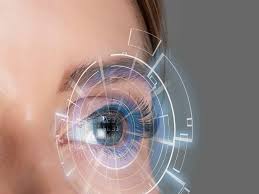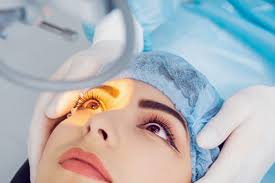Table of Contents
ToggleYes, doctors do touch your eye during the LASIK procedure, but modern advancements ensure it’s done with minimal discomfort and precision.
The touch is limited to preparing your eye for the surgery and using the equipment to create and reshape the cornea.
LASIK, or Laser-Assisted in Situ Keratomileusis, is one of the most commonly performed laser eye surgeries to correct vision problems such as nearsightedness, farsightedness, and astigmatism. If you’re considering LASIK, you might have concerns about what the procedure involves, particularly whether a doctor physically touches your eye. This blog aims to provide a detailed explanation of how the procedure works, what touch entails during LASIK, and why you shouldn’t be worried.
Understanding LASIK Surgery
LASIK is a highly effective and well-established procedure that reshapes the cornea to allow light to focus correctly on the retina. This precision eliminates or reduces the need for eyeglasses or contact lenses. The surgery is quick, usually lasting around 30 minutes for both eyes and is almost entirely pain-free due to numbing drops applied before the surgery.
The procedure uses advanced laser technology, but certain steps require the surgeon’s involvement, particularly preparing the eye and ensuring the equipment works as intended. Below, we’ll break down the process into clear stages and examine where the doctor’s touch comes in.
The LASIK Procedure Step-by-Step
1. Preparation Phase
Before the surgery begins, your doctor prepares your eyes. This preparation involves:
- Application of Numbing Drops: The surgeon uses anaesthetic eye drops to numb your eye and ensure you don’t feel pain during the surgery. This is a necessary step, and doctors may gently hold your eyelids to administer the drops accurately.
- Positioning Your Eye: A special instrument, called a speculum, is used to keep your eyelids open. The doctor places this device carefully but firmly, which is considered physical contact with your eye area.
2. Creating the Corneal Flap
This is one of the most critical stages of the LASIK procedure and involves your eye briefly coming into contact with the surgeon or medical instruments.
- Mechanical Microkeratome or Femtosecond Laser: The surgeon uses either a mechanical blade (microkeratome) or a femtosecond laser to create a thin, hinged flap in the cornea. During this process:
- If a microkeratome is used, the surgeon may align the instrument on your eye physically to ensure precision.
- If a femtosecond laser is used, the setup is automated, but the surgeon may touch your eye or guide its positioning as part of the process.
- The flap is then lifted gently to access the corneal tissue beneath. This part requires very delicate handling, and the surgeon does so with advanced tools and expertise.
It’s important to note that this contact is controlled, sterile, and brief. Modern tools minimise the need for manual work.
3. Reshaping the Cornea
Once the corneal flap is lifted, an excimer laser reshapes the cornea. This step doesn’t involve any physical touch by the doctor, as the laser is programmed based on exact measurements taken during your pre-surgery consultation.
However, the surgeon remains present to monitor the laser and ensure everything operates smoothly. You might feel some pressure, but this is entirely normal and not related to the doctor physically touching your eye at this stage.
4. Repositioning the Corneal Flap
After the cornea is reshaped, the surgeon gently places the corneal flap back into its original position. During this step:
- The surgeon may use a specialised tool to smooth the flap and ensure it adheres naturally to the eye.
- This touch is typically light and doesn’t result in pain due to the numbing drops.
The corneal flap naturally seals itself without needing stitches, which is one of the miraculous aspects of LASIK surgery.
5. Post-Operative Care
At the end of the procedure, the surgeon examines your eye under a microscope to ensure the flap is perfectly positioned before completing the surgery. This close inspection may involve minor adjustments, which could count as a physical touch.
Why Do Doctors Need to Touch the Eye?
Some people may feel apprehensive about the idea of a doctor touching their eye, but it’s a crucial part of ensuring the success and safety of the surgery. Here’s why touch is sometimes necessary:
- Precision: Guided touch ensures that instruments are properly aligned with your eye, which is critical for a procedure as precise as LASIK.
- Safety: Surgeons use their expertise to handle the eye carefully and make adjustments that technology alone cannot achieve.
- Control: Despite the high-tech lasers used in LASIK, surgeons use their hands to complete steps that require a human touch to accommodate individual variations.
Surgeons undergo extensive training to perform LASIK, and their touch is guided by expertise and surgical precision. You can rest assured that every action is sterile, controlled, and with minimal discomfort to you.
Does LASIK Hurt When the Doctor Touches Your Eye?
No, LASIK does not hurt, thanks to the application of anaesthetic eye drops at the beginning of the treatment. The numbing drops effectively block sensations, ensuring you won’t feel pain even during the moments when the doctor touches your eye.
Some patients report feeling mild pressure or a slight sensation at certain stages, but these are temporary and not considered painful. Additionally, most LASIK procedures are completed in just minutes for each eye, minimising any potential discomfort.
What Are the Benefits of Doctor-Patient Interaction During LASIK?
While modern technology plays a significant role in LASIK, human touch remains important for reasons such as:
- Customisation: Each eye is unique, and a skilled surgeon can make adjustments that suit your specific anatomy and needs.
- Reassurance: A caring and confident touch from the surgeon can help put you at ease during the procedure.
- Safety Measures: Surgeons assess your responses in real time to ensure everything goes as planned.
Precautions Taken to Ensure a Safe Touch
Understanding the strict protocols in place might help alleviate concerns about physical touch during LASIK. Surgeons follow these steps:
- Sterilisation: Every tool that comes into contact with your eye is thoroughly sterilised to prevent infection.
- Precision Techniques: Surgeons are trained to minimise unnecessary contact with your eye, focusing only on essential steps.
- Patient Monitoring: Throughout the surgery, your eye movements are tracked to ensure precise actions, making any touch as safe as possible.
Frequently Asked Questions About LASIK
Will I See the Doctor Touching My Eye?
Since you’ll be awake during the procedure, you might see the surgeon’s hands or tools near your eye. However, the numbing drops combined with the gentle nature of the touch mean it won’t cause any discomfort.
How Do I Know If My Surgeon Is Experienced?
Choosing an experienced LASIK surgeon is key to ensuring a successful procedure. Look for certifications, reviews, and a strong history of performing LASIK surgeries.
Can I Blink During the Surgery?
No need to worry—your eye is held open with a speculum, and the numbing drops prevent the reflex from blinking.
Final Thoughts on Doctors Touching Your Eye During LASIK
LASIK surgery is a blend of cutting-edge technology and human expertise. While there is some degree of physical contact, it is minimal, precise, and 100% safe. The brief moments when your doctor touches your eye are all part of delivering life-changing results.
If the thought of LASIK still makes you nervous, remember this: Millions of people undergo LASIK safely each year, and most report significant improvements in their vision.
Considering LASIK? Consult an experienced ophthalmologist to discuss your concerns and assess your eligibility. With proper guidance and a trusted surgeon, the path to clearer vision is just one step away!













